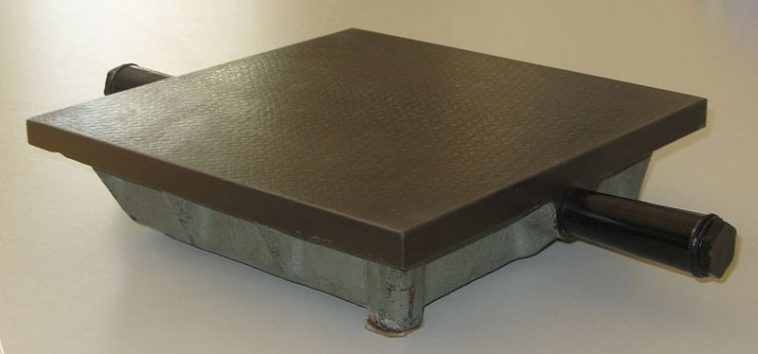A surface plate is one of the versatile, common and important tools in the manufacturing industry. It is a broad, flat, horizontal surface that is used to test or inspect the surface flatness of the workpiece. Surface plates are also used in layout, tooling set up, and gauging. They come in different size ranges like 12 x 12 inches to 6 x 12 feet and weigh up to 10 tons; and different grades like: Grade AA (Laboratory grade), Grade A (Inspection grade), Grade B (Toolroom grade), and Workshop grade which is the least accurate, and not suitable for CNC applications.
Build plate surface for 3D printing
Sometimes confused with a surface plate, a build plate in 3D printing provides that perfect surface for the bottom layer of the print. A build plate could be used for metal 3D printing, brass 3D printing, bronze 3D printing, copper or even metal 3D printing.
Surface plate materials
According to the materials, surface plates could be made from:
- Granite
- Cast iron
- Glass Plate
- Steel
The material to be used depends on the size of the surface plate, what will be placed on it and what will be its weight, and the material’s wear resistance. An ideal surface plate material must have a higher degree of rigidity, higher surface finish, be resistant to wear and corrosion, and be free from warping.
Before zeroing in the material, manufacturers assess all the suitable material prerequisites.
Now, let us look in detail about each of the materials and their pros and cons.
Granite:
With a finer texture and homogeneous appearance, granite is considered to be one of the best and popular materials since the time of World War II where it was saved for use in critical applications. These plates are made either from pink or black granite. The light and dark constituents and the minerals are applied uniformly. Granite plates can support a total normal load of 25 kgs per 0.1 sq mtr, and each plate contains an accuracy certificate as per the standards. They have a hardness ranging between 5.6 to 7 on Moh’s scale. There are different sizes of granite plates starting from 160 x 100, 250 x 160, 250 x 250, 400 x 250, usually up to 6000 x 2000. The Flat Tolerances differ in terms of Grade 0, 1, 2 and 3 according to the sizes.
Advantages of granite surface plate
- Resistant to chemicals and corrosion
- Easy to clean and maintain
- Naturally rigid and hard-wearing
- High vibration damping
- No rusting
- Low sensitivity to dimensional change due to temperature variations
- Harder and denser than steel
- Greater precision and longer wear
- Less of warping
- Low thermal expansion
On the cons side, granite tends to get distorted due to high humidity and may not be able to tolerate beating.
Glass:
Glass surface plate materials are also common these days with an accuracy in the range 0.004 to 0.008 mm.
Advantages of glass
- Less weight
- Free from corrosion
- High accuracy and maintenance for longer life
On the flip side, glass surface plates cannot bear heavy pieces and may shatter or be destroyed.
Cast iron:
Cast iron was prominent in the olden days. It is hand-scraped for a minimum local deviation for flatness; castings are stress relieved to relieve internal stresses; with hollow heavy ribbed bases, cast iron is mainly used for general layout work. These plates come in only two Grades 1 and 2 with an accuracy of +/-0.002 mm to +/-0.005 mm.
Advantages of cast iron
- Higher stability, rigidity and wear quality
- No distortion
- Higher temperature stability
The problems with cast iron are that they are more prone to wearing and warping, that is, when something sharp is dropped on the plate, it may dent and cause high spots.
How to care for surface plates?
Here are some general tips to take care of the surface plate, irrespective of the material it is made of:
- As a rule of thumb, surface plates must be calibrated on a regular basis to keep a check on dents and marks like every six months to 3 years. It is also better to test the plate with a repeat-o-meter.
- No objects should be placed on surface plates except the gages and other measuring pieces. They must be used only for the intended purpose.
- Keep the plates away from debris, dirt, grease, grime and other foreign particles which damages the surface and cause the plate to wear faster. Plus it will create errors in measurement. Clean them with alcohol- or acetone-based professional granite solutions for best results. Avoid water-based solutions because granite tends to absorb water.
- Keep the plate covered when not in use.
- Rotate the plates from time to time to reduce the forming of localized wear spots.
- Do not lift a granite surface plate with a forklift by placing the metal forks.
- Granite plates are supported by hard rubber pads which are important in accuracy and hence not to be removed during manufacturing, lapping, inspection and shipping.
- Don’t over tighten hold down bolts to prevent surface damage, and do not exceed the torque limits.
- Ensure the temperature is stable and consistent for highest repeatability and accuracy.



